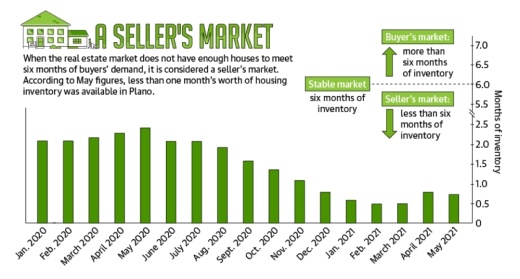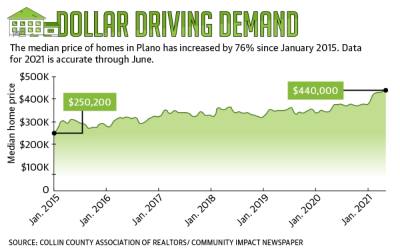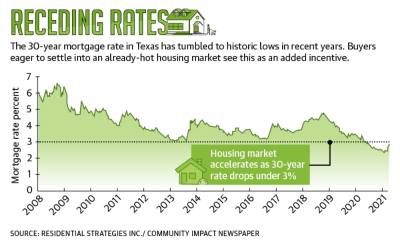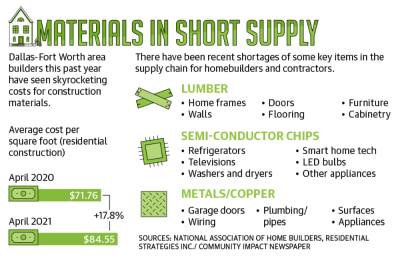“We are seeing inventory levels at a 50-year low,” said Marvin Jolly, a Plano-based Realtor and chairman of real estate advocacy group Texas Realtors. “It’s not just perception—it’s reality.”
As of May, there was 0.8 months worth of housing inventory in Plano, down from 2.4 months in May 2020, according to data provided by Collin County Association of Realtors. A stable market is one that has six months worth of homes available to buy, according to the Texas Real Estate Research Center.
A lack of supply and the rapid pace of sales are behind the surge in home costs in Plano and beyond, said Chris Kelly, president and CEO of Ebby Halliday, which recently relocated its headquarters to the city. May data lists the median sales price in Plano as $430,400, an increase of about 25% year-over-year.
“The million-dollar price point has been on fire—anything above that has been selling at an accelerated pace—but when it comes to someone looking to buy in the [$200,000 and $300,000 price range], that is a very difficult property to find right now,” Kelly said.
Despite these challenges, real estate experts hold out hope that inventory levels will go up as seller confidence is restored and issues around the building supply chain are resolved.
“We do expect the market to slow down,” said Jim Gaines, an economist with the Texas Real Estate Research Center. “The dominoes have to fall in the right order and at the right time.”
Effect on first-time homebuyers
High levels of demand mean most homes are selling for above asking price. But the bank will only approve a loan for what a home is worth, said Lisa-Marie Thompson, a loan officer with Primary Residential Mortgage Inc., which has offices across the metroplex, including one in Plano.
Many first-time homebuyers do not have the cash on hand to make up the difference, Thompson said. May data from the Collin County Association of Realtors shows the median home in Plano sold for 104.4% over asking price, which is up from the 98.2% recorded a year prior.
“This isn’t a market that is feasible for them,” she said. “It’s almost impossible.”
As a result, millennials and other first-time homebuyers are leaving Plano and moving to less populated counties—such as Grayson, Kaufman, Hill, Parker and Ellis counties—that have a greater supply of homes at lower price points, Kelly said.
“We are seeing sales growth in those counties, sometimes 30% to 40% year-over-year,” he said. “Part of the reason is when you get out to those areas, the affordability starts to come down.”
Mary Reeves, a Plano-based Realtor with Ebby Halliday, said most of her current clients are empty-nesters who have the cash on hand to go above asking price. But even those buyers are having to be flexible about what they are willing to accept in a home, Reeves said.
“They are having to say certain things are OK that they probably wouldn’t have a few years ago,” she said. “Most of that has been in updates—they think, ‘OK, I can just update it later.’”
After touring around 70 homes and putting in above-asking offers on three properties, Erin Frey and her husband purchased a house near Coit Road and Park Boulevard in Plano. She said they had a wishlist for what they wanted in a home but were forced to make a slew of concessions due to the lack of available options in their price range of around $400,000.
“It’s not the ideal neighborhood that we would have liked to move into, but it’s the one that we’re in,” Frey said.
Buyers looking to purchase a home right now should set realistic expectations about what they can find under current market conditions, she said.
“Make your hierarchy of needs but be ready to settle and move fast,” she said.
Resolving issues of supply
Skyrocketing prices are not the only thing preventing first-time homebuyers from entering the market. Baby boomers and other older residents are aging in place, which is curtailing resale inventory, Kelly said.
“What we have found is that people are living longer, they’re healthier, and they’re staying in their homes longer,” Kelly said. “So there wasn’t this natural migration out of homes ... that would have created a supply as millennials grew into the homebuying age.”’
The prevalence of investors buying single-family homes as rental properties is also responsible for low levels of supply, Jolly said, noting he estimates 30% of buyers in the metroplex are investors.
“A lot of them have a very, very high level of cash,” he said. “So, they’re putting either 50% down or in some cases 100% cash down.”
Jolly said his association is working with the National Association of Realtors and state legislators to enact policies that would alleviate housing affordability and supply issues. One strategy is to ease VA and FHA loan restrictions around paying above-asking prices, he said.
Land, supply chain complications
Despite a lack of available space, interest from builders in Plano persists, particularly with an eye on multifamily developments. The city is just over 95% built-out, according to Plano officials.
“Long term, eventually, the answer is more units. ... That’s going to require some new thinking, some new perspective on redevelopment of aging areas in Plano,” Jolly said.
Driven by demand, developers are increasingly looking at less conventional routes to new homes. That may include converting commercial zoning to residential, Jolly said.
“There is a lot of office space that is vacant, and it may stay vacant for a long time as the workforce moves virtually,” he said.
Of course, even when there is available land, disruptions to the supply chain have further complicated the job for homebuilders.
According to the National Association of Home Builders (NAHB), aggregate construction material costs are up 12% year-over-year and lumber costs have increased by as much as 300% since last April.
And while contractors have had to deal with shortages and price spikes in the past, it is often just with one item at a given time. There are documented issues with lumber, metals and semiconductor chips, among other materials.
Taken together, land and supply chain challenges are helping to drive prices up. NAHB data suggests recent material cost increases have raised the price of a new single-family home by $36,000 over the past 12 months.
What the future holds
Experts do not predict a crash similar to what was experienced following the 2008 housing crisis. National statistics from the Mortgage Bankers Association indicate lenders are being more restrictive, according to Gaines.
“[Mortgage] lending has not been excessive,” he said. “[Lenders are] requiring a higher FICO score, a lower debt-to-income ratio, and, in many cases, a higher down payment.”
Interest rates have increased slightly since plummeting to historic lows at the beginning of the pandemic, Thompson said. But they continue to remain optimal for potential homebuyers looking to secure a low monthly payment.
“Anything below 4% is still a beautiful interest rate on a mortgage,” she said.
Relatively low interest rates will keep buyer demand high, Kelly said. This, coupled with the fact that North Texas is a highly desirable place to live, means the Plano market could continue to fire on all cylinders for the foreseeable future, he said.
Steven Ryzewski contributed to this report.








